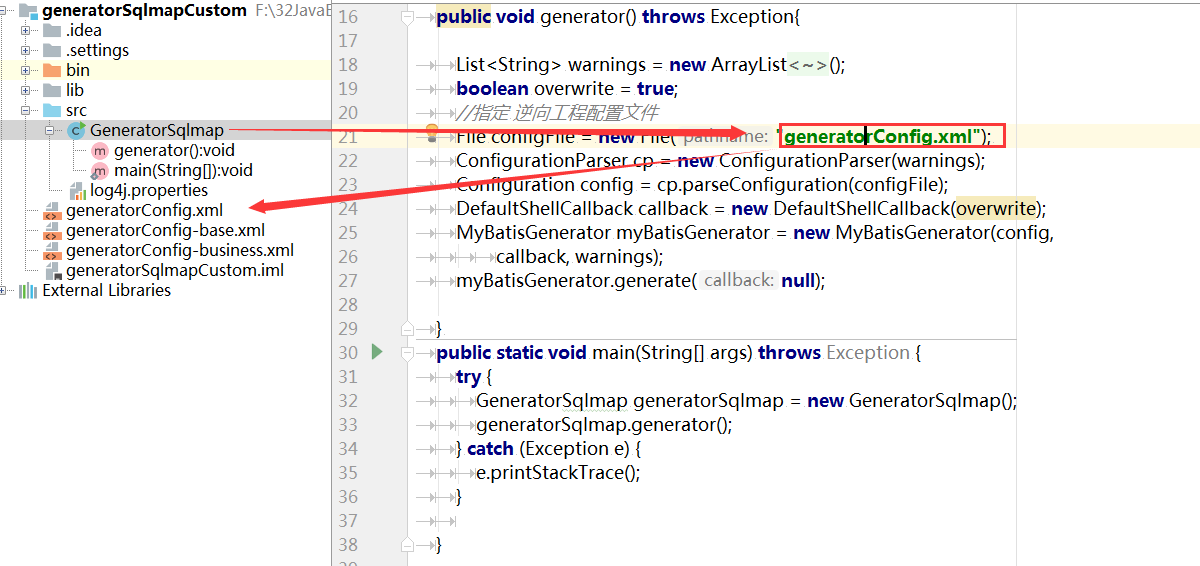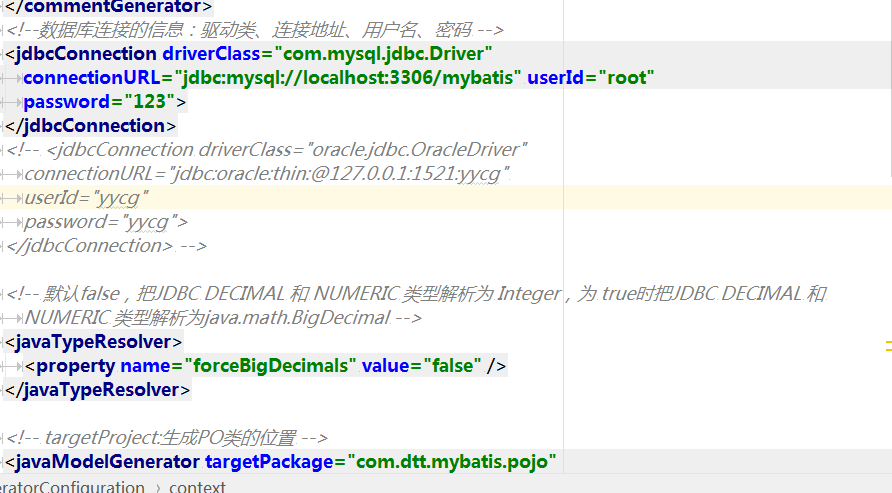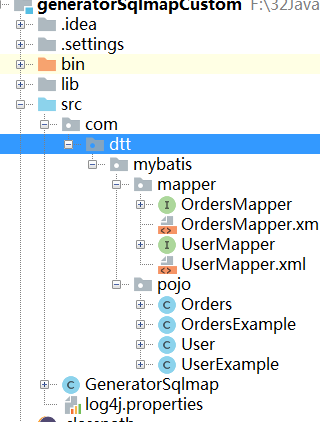深入浅出Mybatis(九)逆向工程
一, 前一篇博客中,介绍了一下Mybatis和hibernate的对比,在这一篇博客说说mybatis的逆向工程,展示一下,只要有一个数据库,你的持久层,你的D层从此不用你自己手写了。
二、什么是逆向工程?
mybaits需要程序员自己编写sql语句,mybatis官方提供逆向工程 可以针对单表自动生成mybatis执行所需要的代码(mapper.java,mapper.xml、pojo),企业实际开发中,常用的逆向工程方式:由于数据库的表生成java代码。
三、Mybatis中逆向工程的使用
导入
- 导入已有的数据库,小编已经导入自己编写好的数据库,数据库结构如下:

把generatorSqlmapCustom JavaProject导入

修改配置文件的数据库连接以及数据库

指定数据库表

生成表对应的实体类
1 2 3 4 5 6 7 | <javaModelGenerator targetPackage="com.dtt.mybatis.pojo" targetProject=".\src"> <!-- enableSubPackages:是否让schema作为包的后缀 --> <property name="enableSubPackages" value="false" /> <!-- 从数据库返回的值被清理前后的空格 --> <property name="trimStrings" value="true" /></javaModelGenerator> |
mapper映射文件生成
1 2 3 4 5 6 | <!-- targetProject:mapper映射文件生成的位置 --> <sqlMapGenerator targetPackage="com.dtt.mybatis.mapper" targetProject=".\src"> <!-- enableSubPackages:是否让schema作为包的后缀 --> <property name="enableSubPackages" value="false" /> </sqlMapGenerator> |
mapper接口生成
1 2 3 4 5 6 7 | <!-- targetPackage:mapper接口生成的位置 --> <javaClientGenerator type="XMLMAPPER" targetPackage="com.dtt.mybatis.mapper" targetProject=".\src"> <!-- enableSubPackages:是否让schema作为包的后缀 --> <property name="enableSubPackages" value="false" /> </javaClientGenerator> |
几个关键属性:
javaModelGenerator :实体类生成;
sqlMapGenerator :映射文件生成;
javaClientGenerator :接口生成;
targetProject:生成文件的位置,本例中.\src,是指src下的目录;
targetPackage:生成包的名称;
修改完成后,运行GeneratorSqlmap.java中的main方法,就可以生成。

以User表为例,展示生成的代码:
- User.java
12345678910111213141516171819202122232425262728293031323334353637383940414243444546474849505152535455
packagecom.dtt.mybatis.pojo;importjava.util.Date;publicclassUser {privateInteger id;privateString username;privateDate birthday;privateString sex;privateString address;publicInteger getId() {returnid;}publicvoidsetId(Integer id) {this.id = id;}publicString getUsername() {returnusername;}publicvoidsetUsername(String username) {this.username = username ==null?null: username.trim();}publicDate getBirthday() {returnbirthday;}publicvoidsetBirthday(Date birthday) {this.birthday = birthday;}publicString getSex() {returnsex;}publicvoidsetSex(String sex) {this.sex = sex ==null?null: sex.trim();}publicString getAddress() {returnaddress;}publicvoidsetAddress(String address) {this.address = address ==null?null: address.trim();}}- UserMapper.java
这里生成了所有的增删改查的sql语句,调用的时候就直接使用对应的方法就可以了很方便吧。(重点学习一下自动生成的代码是如何封装的)
123456789101112131415161718192021222324252627282930packagecom.dtt.mybatis.mapper;importcom.dtt.mybatis.pojo.User;importcom.dtt.mybatis.pojo.UserExample;importjava.util.List;importorg.apache.ibatis.annotations.Param;publicinterfaceUserMapper {intcountByExample(UserExample example);intdeleteByExample(UserExample example);intdeleteByPrimaryKey(Integer id);intinsert(User record);intinsertSelective(User record);List<User> selectByExample(UserExample example);User selectByPrimaryKey(Integer id);intupdateByExampleSelective(@Param("record") User record,@Param("example") UserExample example);intupdateByExample(@Param("record") User record,@Param("example") UserExample example);intupdateByPrimaryKeySelective(User record);intupdateByPrimaryKey(User record);}UserMapper.xml
123456789101112131415161718192021222324252627282930313233343536373839404142434445464748495051525354555657585960616263646566676869707172737475767778798081828384858687888990919293949596979899100101102103104105106107108109110111112113114115116117118119120121122123124125126127128129130131132133134135136137138139140141142143144145146147148149150151152153154155156157158159160161162163164165166167168169170171172173174175176177178179180181182183184185186187188189190191192193194195196197198199200201202203204205206207208209210211212<?xml version="1.0"encoding="UTF-8"?><!DOCTYPE mapper PUBLIC"-//mybatis.org//DTD Mapper 3.0//EN""http://mybatis.org/dtd/mybatis-3-mapper.dtd"><mapper namespace="com.dtt.mybatis.mapper.UserMapper"><resultMap id="BaseResultMap"type="com.dtt.mybatis.pojo.User"><id column="id"property="id"jdbcType="INTEGER"/><result column="username"property="username"jdbcType="VARCHAR"/><result column="birthday"property="birthday"jdbcType="DATE"/><result column="sex"property="sex"jdbcType="CHAR"/><result column="address"property="address"jdbcType="VARCHAR"/></resultMap><sql id="Example_Where_Clause"><where ><foreach collection="oredCriteria"item="criteria"separator="or"><iftest="criteria.valid"><trim prefix="("suffix=")"prefixOverrides="and"><foreach collection="criteria.criteria"item="criterion"><choose ><when test="criterion.noValue">and ${criterion.condition}</when><when test="criterion.singleValue">and ${criterion.condition} #{criterion.value}</when><when test="criterion.betweenValue">and ${criterion.condition} #{criterion.value} and #{criterion.secondValue}</when><when test="criterion.listValue">and ${criterion.condition}<foreach collection="criterion.value"item="listItem"open="("close=")"separator=",">#{listItem}</foreach></when></choose></foreach></trim></if></foreach></where></sql><sql id="Update_By_Example_Where_Clause"><where ><foreach collection="example.oredCriteria"item="criteria"separator="or"><iftest="criteria.valid"><trim prefix="("suffix=")"prefixOverrides="and"><foreach collection="criteria.criteria"item="criterion"><choose ><when test="criterion.noValue">and ${criterion.condition}</when><when test="criterion.singleValue">and ${criterion.condition} #{criterion.value}</when><when test="criterion.betweenValue">and ${criterion.condition} #{criterion.value} and #{criterion.secondValue}</when><when test="criterion.listValue">and ${criterion.condition}<foreach collection="criterion.value"item="listItem"open="("close=")"separator=",">#{listItem}</foreach></when></choose></foreach></trim></if></foreach></where></sql><sql id="Base_Column_List">id, username, birthday, sex, address</sql><select id="selectByExample"resultMap="BaseResultMap"parameterType="com.dtt.mybatis.pojo.UserExample">select<iftest="distinct">distinct</if><include refid="Base_Column_List"/>from user<iftest="_parameter != null"><include refid="Example_Where_Clause"/></if><iftest="orderByClause != null">order by ${orderByClause}</if></select><select id="selectByPrimaryKey"resultMap="BaseResultMap"parameterType="java.lang.Integer">select<include refid="Base_Column_List"/>from userwhere id = #{id,jdbcType=INTEGER}</select><delete id="deleteByPrimaryKey"parameterType="java.lang.Integer">delete from userwhere id = #{id,jdbcType=INTEGER}</delete><delete id="deleteByExample"parameterType="com.dtt.mybatis.pojo.UserExample">delete from user<iftest="_parameter != null"><include refid="Example_Where_Clause"/></if></delete><insert id="insert"parameterType="com.dtt.mybatis.pojo.User">insert into user (id, username, birthday,sex, address)values (#{id,jdbcType=INTEGER}, #{username,jdbcType=VARCHAR}, #{birthday,jdbcType=DATE},#{sex,jdbcType=CHAR}, #{address,jdbcType=VARCHAR})</insert><insert id="insertSelective"parameterType="com.dtt.mybatis.pojo.User">insert into user<trim prefix="("suffix=")"suffixOverrides=","><iftest="id != null">id,</if><iftest="username != null">username,</if><iftest="birthday != null">birthday,</if><iftest="sex != null">sex,</if><iftest="address != null">address,</if></trim><trim prefix="values ("suffix=")"suffixOverrides=","><iftest="id != null">#{id,jdbcType=INTEGER},</if><iftest="username != null">#{username,jdbcType=VARCHAR},</if><iftest="birthday != null">#{birthday,jdbcType=DATE},</if><iftest="sex != null">#{sex,jdbcType=CHAR},</if><iftest="address != null">#{address,jdbcType=VARCHAR},</if></trim></insert><select id="countByExample"parameterType="com.dtt.mybatis.pojo.UserExample"resultType="java.lang.Integer">select count(*) from user<iftest="_parameter != null"><include refid="Example_Where_Clause"/></if></select><update id="updateByExampleSelective"parameterType="map">update user<set ><iftest="record.id != null">id = #{record.id,jdbcType=INTEGER},</if><iftest="record.username != null">username = #{record.username,jdbcType=VARCHAR},</if><iftest="record.birthday != null">birthday = #{record.birthday,jdbcType=DATE},</if><iftest="record.sex != null">sex = #{record.sex,jdbcType=CHAR},</if><iftest="record.address != null">address = #{record.address,jdbcType=VARCHAR},</if></set><iftest="_parameter != null"><include refid="Update_By_Example_Where_Clause"/></if></update><update id="updateByExample"parameterType="map">update userset id = #{record.id,jdbcType=INTEGER},username = #{record.username,jdbcType=VARCHAR},birthday = #{record.birthday,jdbcType=DATE},sex = #{record.sex,jdbcType=CHAR},address = #{record.address,jdbcType=VARCHAR}<iftest="_parameter != null"><include refid="Update_By_Example_Where_Clause"/></if></update><update id="updateByPrimaryKeySelective"parameterType="com.dtt.mybatis.pojo.User">update user<set ><iftest="username != null">username = #{username,jdbcType=VARCHAR},</if><iftest="birthday != null">birthday = #{birthday,jdbcType=DATE},</if><iftest="sex != null">sex = #{sex,jdbcType=CHAR},</if><iftest="address != null">address = #{address,jdbcType=VARCHAR},</if></set>where id = #{id,jdbcType=INTEGER}</update><update id="updateByPrimaryKey"parameterType="com.dtt.mybatis.pojo.User">update userset username = #{username,jdbcType=VARCHAR},birthday = #{birthday,jdbcType=DATE},sex = #{sex,jdbcType=CHAR},address = #{address,jdbcType=VARCHAR}where id = #{id,jdbcType=INTEGER}</update></mapper>小结
逆向工程在很多软件里面都有,比如EA的逆向工程,PB的逆向工程。还有很多,总之,这个就是其中的一些很有价值的东西,在企业运用的时候很方便,而且这些生成好的类,尽量不要去修改,如果非要修改的话,可以用pv类来实现继承拓展。这是很好的选择。




【推荐】还在用 ECharts 开发大屏?试试这款永久免费的开源 BI 工具!
【推荐】国内首个AI IDE,深度理解中文开发场景,立即下载体验Trae
【推荐】编程新体验,更懂你的AI,立即体验豆包MarsCode编程助手
【推荐】轻量又高性能的 SSH 工具 IShell:AI 加持,快人一步
· 理解Rust引用及其生命周期标识(下)
· 从二进制到误差:逐行拆解C语言浮点运算中的4008175468544之谜
· .NET制作智能桌面机器人:结合BotSharp智能体框架开发语音交互
· 软件产品开发中常见的10个问题及处理方法
· .NET 原生驾驭 AI 新基建实战系列:向量数据库的应用与畅想
· C# 13 中的新增功能实操
· Ollama本地部署大模型总结
· 2025成都.NET开发者Connect圆满结束
· langchain0.3教程:从0到1打造一个智能聊天机器人
· 用一种新的分类方法梳理设计模式的脉络